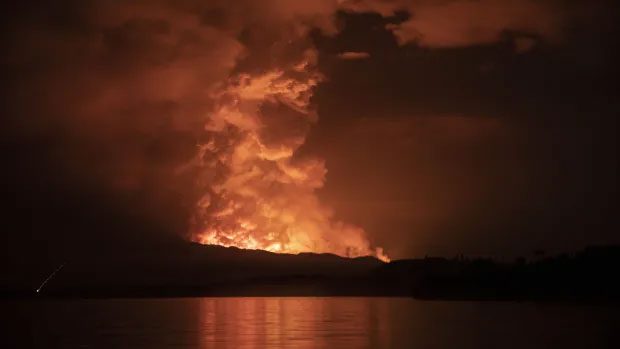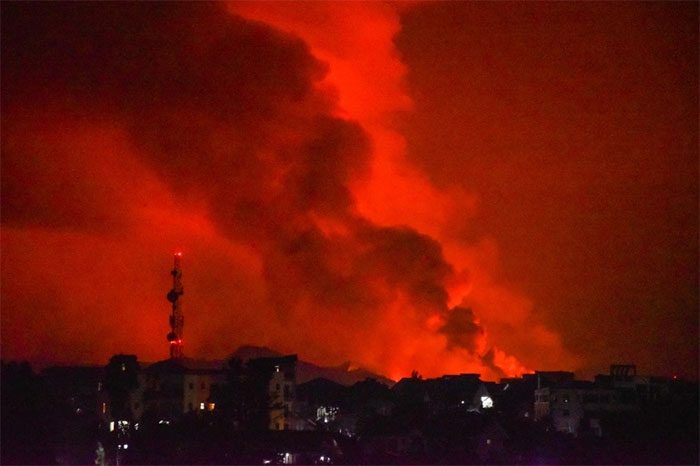Last year, one of the most dangerous volcanoes in Africa erupted without warning. Scientists now know the reason.
According to the New York Times, Nyiragongo is a tall volcano in the Democratic Republic of the Congo, always in a state of activity. This volcano is surrounded by a rare lava lake, continuously replenished by bubbling magma below. However, on May 22, 2021, the materials inside the volcano found another way to escape. They flowed from cracks on the volcano’s slopes towards the city of Goma, resulting in at least 31 deaths, 750 injuries, and thousands of people displaced.

Smoke column erupting from the Nyiragongo volcano in the Democratic Republic of the Congo on May 22, 2021. (Photo: AFP/TTXVN)
In a new study published in the journal Nature, Delphine Smittarello, a geophysicist at the European Centre for Geodynamics and Seismology in Walferdange (Luxembourg), and her colleagues clearly explained why this volcano surprised everyone with its unusually sudden eruption.
Most well-monitored volcanoes show warning signals before an eruption. Magma moving through rock creates specific types of earthquakes, deforms the ground as it rises, and releases toxic gases. Some volcanoes are so active that they constantly produce notable disturbances, but just a distinct change in normal behavior allows scientists to detect an impending eruption.
Nyiragongo was not like that in 2021. To any expert, this volcano appeared to be behaving normally.
Smittarello, the lead author of the study, stated: “We did not detect any significant changes that could indicate an impending eruption.”
Her team suggested that before the unexpected eruption occurred, magma had intruded beneath the slopes of Nyiragongo. However, the magma then waited. Not only did it wait silently, but the molten mass was so close to the surface that if the slope were to break, the magma would erupt immediately without the usual audible warning signs.
The slope’s failure was just a matter of time. On May 22, the weakened slope eventually succumbed to the magma. Within six hours, the volcano erupted through the new cracks.
Emily Montgomery-Brown, a geophysicist at the United States Geological Survey, noted that this type of unannounced eruption teaches scientists a hard lesson: There are always things we do not understand, and we should not be complacent.
With unusual fluidity, lava flows quickly and emits large amounts of CO2 into the surrounding environment, Nyiragongo poses an extreme danger to Goma in the Democratic Republic of the Congo and Gisenyi – a neighboring city in Rwanda.

Smoke and fire during the volcanic eruption at Mount Nyiragongo near Goma, Democratic Republic of the Congo on May 22, 2021. (Photo: Reuters)
Eruptions on the slopes of Nyiragongo in 1977 and 2002 killed hundreds of people, but both times there were signs indicating that magma was about to rise to the surface. These signs included significant earthquakes, movement of the lava lake, eruptions from the nearby Nyamulagira volcano, and magma conduits underground being drawn into part of Nyiragongo’s magma flow.
Since 2015, a new seismic unit has been established in the area to understand the sounds of Nyiragongo. Partly due to the constantly bubbling lava lake, the sounds it produces are never-ending. Trying to detect unusual changes from this “symphony” is akin to identifying a new voice in a huge crowd of people talking. This is not impossible, but extremely challenging.
Although the Goma Volcano Observatory has faced many difficulties in recent years, its staff and global partners have worked tirelessly to monitor Nyiragongo around the time of the eruption. According to their reports, they did not detect any warning signals before the 2021 eruption.
To ensure that nothing slipped through the cracks, both local and international scientists meticulously examined the scientific data they had collected at that time. Their concerns were confirmed: Nyiragongo showed no unusual seismic activity. Even the most modern observatories would not have seen any signs.
Benoît Smets, a geologist at the Royal Museum for Central Africa in Tervuren (Belgium) and co-author of the study, remarked: “This is a peculiar volcano. Using traditional monitoring methods with Nyiragongo means you will not be able to detect such types of eruptions. This makes this volcano even more dangerous than previously thought.”
The stealthy nature of Nyiragongo is not unique. Other volcanoes can allow lava to escape from cracks relatively quietly, while others can produce sudden steam bursts.


















































